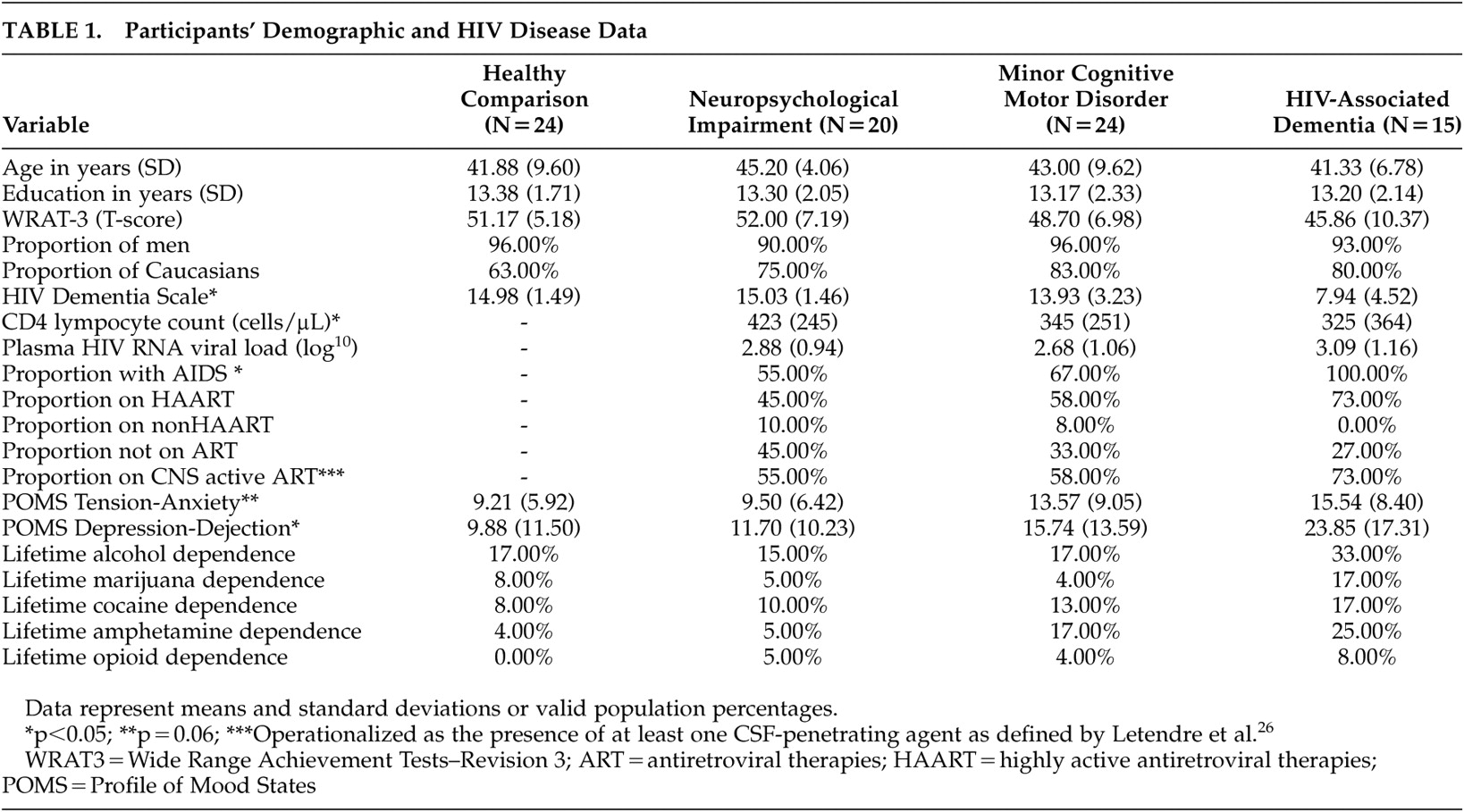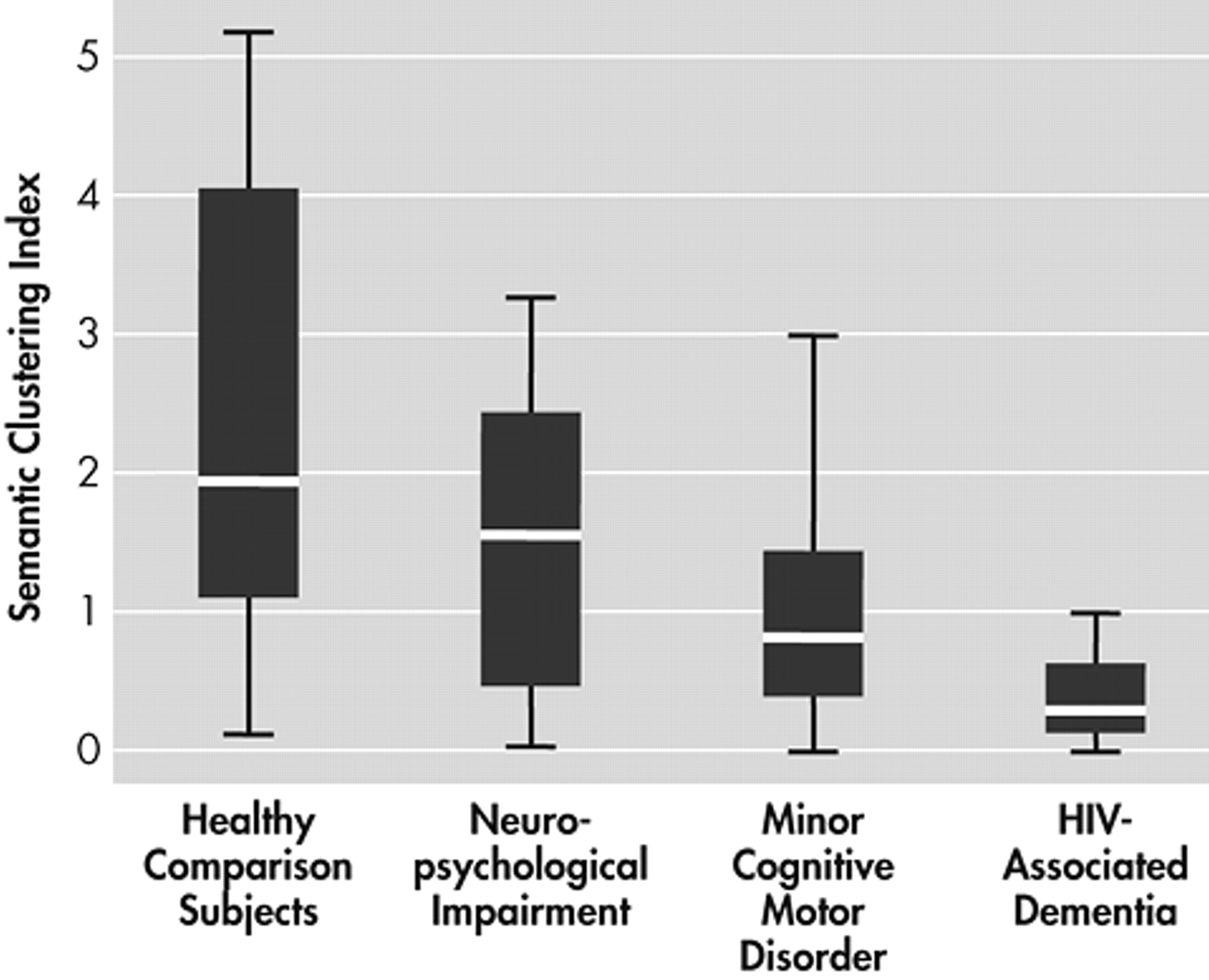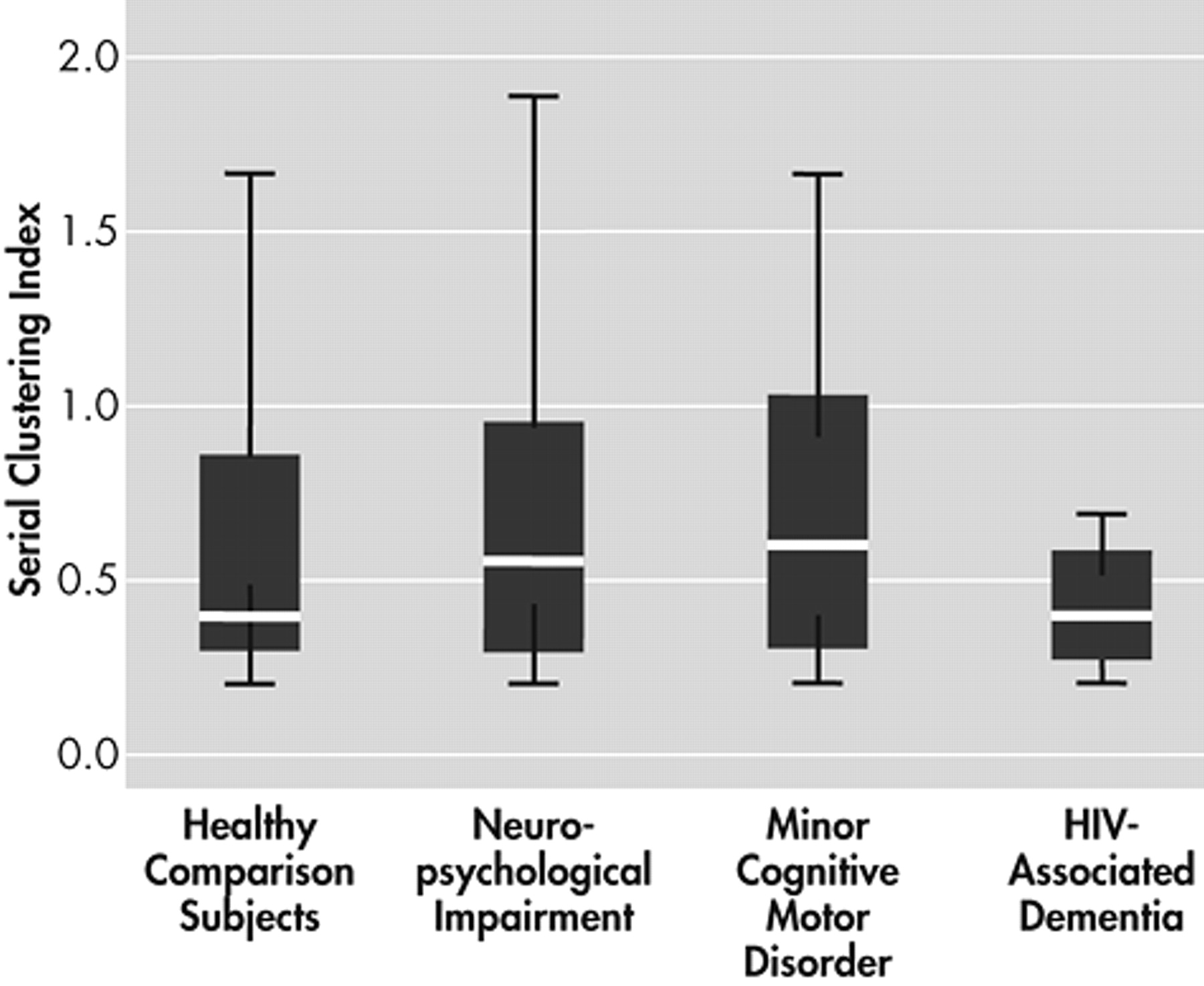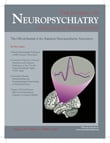A pproximately 5% to 20% of individuals infected with HIV are estimated to develop HIV-associated dementia,
1 a diagnosis characterized by severe cognitive, motor, and neurobehavioral dysfunction that is accompanied by significant disruption in instrumental activities of daily living.
2 Although HIV is found throughout the brain parenchyma, a convergence of evidence from neuroimaging,
3 neuropathology,
4 and neuropsychology
5 support a preferential disruption of fronto-basal ganglia systems in HIV-associated dementia. In particular, numerous neuropsychological findings in HIV-associated dementia have indicated a cognitive profile consistent with the prototypical “subcortical” dementias.
5 Such conditions, including Huntington’s disease, are associated with damage to circuits connecting the frontal lobes and basal ganglia and are thought to be dissociable from dementias in which cortical neuropathology (e.g., medial temporal lobe structures) is more prominent, such as Alzheimer’s disease. Thus, neurobehavioral disturbances commonly reported in HIV-associated dementia include bradyphrenia, bradykinesia, extrapyramidal signs, and apathy,
6 as well as neuropsychological deficits in the areas of executive functions, working memory, verbal fluency, and complex motor skills.
A mild “subcortical” memory profile characterized by impaired learning, with broadly intact delayed retention and recognition, is also common in HIV-associated dementia.
5 For example, White et al.
5 reported a deficit in verbal episodic memory (i.e., overall list learning and recall) in HIV-associated dementia, with relative sparing of verbal semantic memory. However, no studies have examined the cognitive underpinnings of the general episodic learning and memory deficit observed in HIV-associated dementia. Such investigations are important because they may facilitate a clearer understanding of the cognitive mechanisms of impairment, as well as inform compensatory interventional strategies designed to minimize the impact of HIV-associated dementia-associated memory deficits on the performance of instrumental activities of daily living (e.g., medication adherence).
To this end, it is generally acknowledged that greater organization of learned material is associated with improved recall. This is especially important considering the limited capacity of short-term information storage.
7 Therefore, the use of “metacognitive” strategies is desirable to maximize recall performance. In the context of word-list learning, semantic clustering, which takes advantage of semantic relationships between items to facilitate efficient encoding and retrieval, represents one such strategy. Decreased use of semantic clustering has been found in patients with frontal lobe lesions.
8 In addition, the relationship between semantic clustering and recall performance has been demonstrated in numerous populations, including healthy elderly adults,
9 Huntington’s disease,
10 phenylketonuria,
11 methamphetamine dependence,
12 and HIV infection.
13 In contrast, increased use of serial clustering, a less active strategy where recalled words are simply recited back in the same order as the learning word-list, may be less reliably associated with frontal systems pathology.
14 Indeed, prior studies of HIV infection have not observed deficits in serial clustering,
13 even in persons with minor cognitive-motor disorder.
15However, no studies have examined semantic and serial clustering in HIV-associated dementia. It is generally held that cognitive functioning, including episodic verbal memory, declines with advancing HIV disease.
16 Accordingly, the current study focuses on examining the use of active organizational strategies on a verbal memory task in HIV-associated dementia relative to individuals with less severe HIV-associated cognitive disorders. We hypothesized a stepwise decline in the use of semantic clustering across these groups, with the worst performance expected in individuals with HIV-associated dementia. Further, in light of the above-described prior literature on HIV infection, we hypothesized that there would be no between-group differences in serial clustering.
METHOD
Participants
Participants in this study were 24 healthy comparison volunteers and 59 individuals with HIV infection, as indicated by enzyme-linked immunosorbent assays and a Western Blot confirmatory test. Potential participants were excluded if they met any of the following criteria: 1) a history of head injury with loss of consciousness greater than 30 minutes; 2) a history of neurological or psychiatric illness that would adversely affect cognitive functioning (e.g., seizure disorder, CNS opportunistic infections, cerebrovascular accidents, mental retardation, schizophrenia spectrum disorders, or CNS neoplasms); or 3) active illicit substance use confirmed by urine toxicology screening at the time of evaluation.
Consensus diagnoses of HIV-associated neurocognitive disorders were assigned for each participant on the basis of comprehensive neuropsychological, neuromedical, and psychiatric evaluations, and according to modified American Academy of Neurology
2 and Grant and Atkinson
6 criteria. Within this classification system, the term “HIV-associated dementia” is used for individuals with more severe and often more generalized cognitive decline, while “minor cognitive-motor disorder” is used for individuals with definite cognitive impairment but milder instrumental activities of daily living effects than HIV-associated dementia. Subsyndromal neuropsychological impairment is used to describe individuals whose neuropsychological deficits are “subclinical” and do not affect instrumental activities of daily living in a noticeable way. Recent data support the interrater reliability
17 and construct validity
18 of this nosology. Classified in this manner, the HIV-infected participants consisted of 20 individuals with neuropsychological impairment, 24 individuals with minor cognitive-motor disorder, and 15 individuals with HIV-associated dementia.
Participants’ demographic and disease characteristics are displayed in
Table 1 . Consistent with study group definitions, significant omnibus differences were observed on the HIV Dementia Scale
19 (chi-square=18.60, p<0.0005), with lowest scores evident in the HIV-associated dementia group (Z-score=−4.18, p<0.05). As might be expected, the HIV seropositive study cells differed on CD4 lymphocyte counts (F=73.90, p<0.0001) and the proportion of subjects with AIDS (chi-square= 41.86, p<0.0001). However, no significant group differences were evident in plasma HIV RNA viral load or antiretroviral regimens (p>0.10). The four participant groups were comparable for age, years of education, sex and ethnic composition, and estimated premorbid verbal intellectual functioning based on the oral word reading subtest from the Wide Range Achievement Test–Revision 3
20 (p>0.10). Study groups were also comparable with respect to the prevalence of participants with lifetime histories of alcohol, marijuana, cocaine, amphetamine and opioid dependence per structured interviews using DSM-IV
21 criteria (p<0.05). Omnibus group differences emerged on the Profile of Mood States (POMS)
22 Depression-Dejection (p<0.05) and Tension-Anxiety (p=0.06) scales, with the HIV-associated dementia group endorsing more depressive and anxious symptoms for the week prior to evaluation than the healthy comparison and neuropsychological impairment samples (p<0.05).
Procedure
All participants were administered the Hopkins Verbal Learning Test–Revised (HVLT–R).
23 The HVLT-R involves learning a list of 12 words belonging to three semantic categories (animals, precious stones, and human dwellings) over three successive free-recall trials. The order of items in the word list was randomized such that no items from the same category were in adjacent positions. In each trial, participants were read the word list in the same order and immediately asked to recall the items. Recalled items from the three learning trials were used in the current analyses.
Participants also received standardized clinical ratings on measures of executive functioning, working memory, and speed of information processing that were performed by the study neuropsychologists. The clinical ratings were derived from demographically adjusted T scores from published and well-validated clinical measures. Primary tests within the executive function domain included the Trail Making Test, Part B,
24 and Wisconsin Card Sorting Test–64 Card Version.
25 Tests of working memory included the Paced Auditory Serial Addition Test
27 and Wechsler Adult Intelligence Scale–III (WAIS–III)
28 Letter-Number Sequencing subtest. Finally, speed of information processing was assessed with the WAIS-III Processing Speed Index and Trail Making Test, Part A. Clinical ratings were based on a scale ranging from 1 (above average, T score ≥55) to 0 (severely impaired, T score <20), where scores of five and higher (T score <40) represent definite cognitive impairment (see Woods et al.
17 for technical details regarding this methodology, as well as its interrater reliability and construct validity).
Data Analysis
Three variables of interest were derived from each HVLT-R recall trial: number of items correctly recalled, semantic clusters, and serial clusters. A semantic cluster was defined as two successive correctly recalled items from the same semantic category, whereas a serial cluster was operationalized as an adjacent pair of correctly recalled items that were also adjacent in the presented word list, regardless of order. For each recall trial, indices of category clustering and serial clustering were computed by subtracting the number of clusters expected by chance from the number of observed clusters.
29 Negative clustering index values were rounded up to zero. Clustering index values across the three free recall trials were then averaged to reflect semantic and serial organization.
Based on existing literature, the current study sample size afforded adequate power to detect a large effect size (power >0.80). The unbiased Cohen’s
d statistic was used as an estimate of effect size. Both clustering variables of interest were tested for normality of distribution and homogeneity of variance within each HIV-related cognitive status group. Subsequently, a monotonic transformation (natural logarithm) was performed on the semantic clustering index to eliminate inhomogeneity of variance. Additionally, nonparametric statistics were used for group comparisons of both variables due to non-normal distributions. To examine the hypothesized stepwise decline in the use of semantic clustering across HIV-related cognitive status groups, the Jonckheere-Terpstra nonparametric test for ordered alternatives
30,
31 was conducted. This between-group trend test assesses the null hypothesis that the distribution of the dependent variable does not differ among the groups. Essentially, to reject the null hypothesis, the median level of semantic clustering must decrease in an orderly fashion with disease progression. We conducted follow-up pairwise comparisons using Mann-Whitney tests with Bonferroni adjustment for six possible comparisons (critical α=0.0083). Additionally, we used a Kruskal-Wallis test to examine the between-group difference in serial clustering.
RESULTS
Figure 1 shows the degree of semantic clustering exhibited by participants in each group. A Jonckheere-Terpstra test for ordered alternatives showed an orderly decrease in exhibited degree of semantic clustering from healthy comparison, neuropsychological impairment, minor cognitive-motor disorder, and HIV-associated dementia participants, respectively (
J =5.31, p<0.0005). Follow-up pairwise comparisons with Mann-Whitney tests showed significant group differences between healthy comparison and minor cognitive-motor disorder (chi-square=10.75, p<0.0083, d=1.10), healthy comparison and HIV-associated dementia (chi-square=19.02, p<0.0083, d=1.63), and neuropsychological impairment and HIV-associated dementia (chi-square=11.57, p<0.0083, d=1.39); while minor cognitive-motor disorder and HIV-associated dementia groups exhibited a borderline significant between-group difference after Bonferroni adjustment (chi-square =6.69, p=0.01, d=0.93).
Figure 2 shows the degree of serial clustering exhibited by the four participant groups. A Kruskal-Wallis test failed to reject the null hypothesis that the groups differ in their exhibited degree of serial clustering (chi-square=1.85, p>0.05).
As the study groups differed in general cognitive abilities and affective distress, a post hoc analysis was undertaken to more carefully evaluate the hypothesis that deficient executive functions were the driving force behind the semantic clustering findings in HIV-associated dementia. A linear regression was performed using HIV Dementia Scale total, the POMS Depression-Dejection and Tension-Anxiety scales, and the cognitive domain ratings of executive functions, working memory, and information processing speed as predictors of semantic clustering in the entire study sample. Though the overall model was significant (adjusted R 2 =0.15, F=3.12, p<0.01), the executive functions variable emerged as the only significant independent predictor of semantic clustering (F=4.64, p<0.05).
DISCUSSION
To examine the effect of HIV-associated dementia on the use of active organizational strategy during a verbal memory task, we compared the use of semantic and serial clustering between healthy comparison and three groups of HIV-infected individuals with increasing severity of HIV-associated cognitive disorder. Consistent with our hypothesis, there was a statistically significant stepwise decline in the use of semantic clustering, such that the healthy comparison group exhibited the highest clustering, followed by the neuropsychological impairment, minor cognitive-motor disorder and HIV-associated dementia groups, respectively. These findings were associated with large effect sizes and cannot be readily attributed to demographic factors, psychiatric variables, or antiretroviral treatment differences between groups. Moreover, post hoc analysis revealed that semantic clustering was specifically related to executive functioning, and not to performance on measures of working memory, processing speed, or a screening measure of general cognitive abilities. Also consistent with our hypothesis, participant groups were comparable with regard to their use of the serial clustering strategy. It is therefore evident that individuals with HIV-associated dementia experienced the most difficulty utilizing semantic structure as a memory strategy. Consistent with existing literature on HIV-1 infection,
13,
32 semantic clustering impairments were also evident in individuals with neuropsychological impairment and minor cognitive-motor disorder. This finding also parallels the previously demonstrated declines in other cognitive domains across HIV disease status, including executive functions.
5The current study demonstrates an HIV-associated impairment in the utilization of a memory organization strategy often linked to frontal systems functioning. These data support previous cognitive studies suggesting a “subcortical” pattern of neuropsychological deficits in HIV-associated dementia. Prior research has linked HIV-associated dementia to deficits in retrieval from remote memory,
33 verbal episodic memory,
5 and semantic memory.
34 For example, a recent finding from our group suggested that semantic memory retrieval impairments in HIV-associated dementia reflect a disruption in the frontally mediated process of a rule-guided lexical-semantic search, rather than depleted semantic memory stores.
34 The current finding of selective impairment in semantic (versus serial) clustering utilization thus suggests that the observed HIV-associated dementia-associated episodic memory impairment may be attributable to executive dyscontrol of encoding and retrieval, which are mechanisms that have consistently been implicated in HIV-associated cognitive disorders.
15,
31,
33Although HIV-associated frontal systems pathology is hypothesized to underlie the deficient semantic clustering performance in HIV-associated dementia, interpretation of the neuropathogenesis of our data is restricted by the observational and inferential nature of the study design. For example, an alternate interpretation of our findings might be that the HIV-associated dementia-associated semantic clustering impairment reflects generalized cognitive decline and diffuse pathology, rather than the specific effects of frontal systems damage.
35Yet several factors argue against this competing hypothesis. First, executive functions emerged as the only independent predictors of semantic clustering in a statistical model that also included tests of working memory, speed of information processing, and global cognition (i.e., the HDS). Though executive functions are not always synonymous with frontal systems, the specificity of the association between semantic clustering and executive dysfunction demonstrated in this study and the prominent fronto-basal ganglia neuropathophysiology of HIV-associated dementia lend some credence to our interpretation.
Second, functional neuroimaging data in healthy comparison subjects support the primary involvement of the prefrontal cortex in semantic clustering strategy use during free recall.
36 Consistent with this notion, prior research also indicates that semantic clustering deficits are evident in individuals with various frontal systems neuropathologies (e.g., frontal lobe lesions,
8 Huntington’s disease,
10 and methamphetamine dependence).
12 Nevertheless, future studies using neuroimaging and neuropathological techniques are needed to more directly evaluate the neuropathogenesis of semantic clustering deficits in HIV-associated dementia.
Though this study utilized a classification system for HIV-related cognitive disorders with well-demonstrated reliability and validity, the precise trajectory of the observed decline in memory organization is difficult to delineate from a cross-sectional design. A longitudinal study with a similar neuropsychological methodology is therefore desirable to examine the robustness of the current findings. Second, the sample sizes were too small to explore the effects of systemic disease on semantic clustering (e.g., immunosuppression) and data were not available on the qualitative aspects of participants’ histories of substance use (e.g., injection drug use, lifetime quantity, duration of use, and abstinence). Larger study sample sizes will allow for a more thorough investigation of the relationship between semantic clustering and systemic HIV disease (e.g., immunosuppression, CSF viral load, and treatment factors), as well as the potentially additive effects of commonly encountered comorbidities (e.g., substance abuse, hepatitis C coinfection, and aging). Finally, future studies with increased numbers of HIV-infected women and ethnic minorities, especially African Americans and Hispanics, are needed to examine the generalizability of the current findings.
Despite these limitations, the potential clinical implications of deficient semantic clustering in HIV-associated dementia warrant consideration. The benefit of explicit category cuing has been demonstrated in patients with frontal lobe lesions
37 and Parkinson's disease,
38 where previous knowledge of the category structure of a word-list facilitated the use of semantic clustering strategy. This suggests that a cognitive rehabilitation process utilizing mnemonic strategies, such as explicit cuing, may serve to mitigate the functional impact of memory difficulties in patients with HIV-associated dementia. This is especially important in light of the observed relationship between memory deficit and deterioration in instrumental activities of daily living, including management of complex HIV medication regimens.
39Acknowledgments
The research described was supported by NIH grants MH62512, MH59745, and DA12065. The views expressed in this article are those of the authors and do not reflect the official policy or position of the United States government. The authors thank Deborah Lazzaretto for her guidance regarding data analyses, Jennifer Marquie Beck for her work on data coding, and Carolina Posada for editorial assidtance.




